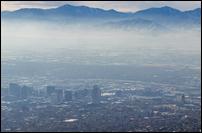Estimated read time: 3-4 minutes
This archived news story is available only for your personal, non-commercial use. Information in the story may be outdated or superseded by additional information. Reading or replaying the story in its archived form does not constitute a republication of the story.
SALT LAKE CITY — Welcome to winter and Utah's first prolonged inversion this season that is choking the Wasatch Front and Cache Valley, leading to mandatory action that prohibits the use of wood-burning devices and has regulators urging people to stay out of their vehicles.
The values for fine particulate matter, or PM2.5, are exceeding the federal clean air threshold in Salt Lake, Davis, Weber and Cache counties in particular, with other areas of the state experiencing moderate conditions as a high-pressure system sets in.
"You could see the inversion start to settle in Sunday," said Kimberly Kreykes, an environmental scientist with the Utah Division of Air Quality.
"It has grown over the last few days ... everything just kind of builds and builds."
Kreykes added that most areas of Salt Lake County are especially bad for air pollution, with unhealthy numbers in the range that pose health problems for sensitive populations such as the elderly, the very young and people with respiratory issues.
The hourly high values are in the 50s, she noted, while the federal threshold is 35 micrograms per cubic meter.
"I really hate saying those numbers," Kreykes said.
PM2.5 is 3% the diameter of a human hair and easily seeps into the lungs. Unhealthy levels of the fine particulate matter have been linked to increased incidence of strokes or heart attacks, aggravation of respiratory conditions and the early onset of dementia.
Utah had a relatively mild inversion last winter because of the lack of snow cover.
A stagnant weather system this week, coupled with snow on the ground from last week's storms, are aggravating harmful pollution levels.

Fare for any ride on Utah Transit Authority buses and trains is free Tuesday and Wednesday due to legislation passed a couple of years ago by Rep. Joel Briscoe, D-Salt Lake City.
The bad air this week also triggered activation of the Surge Telework program for eligible state employees.
Initiated by legislation sponsored in the last legislative session by Sen. Daniel McCay, R-Riverton, the program identifies about 2,500 state employees who are eligible to work from home and stay off the road.
Ashley Sumner, communications director for the Utah Department of Environmental Quality, said the goal is to get 90% of those workers out of their cars to help tamp tailpipe emissions — the largest contributor of PM2.5 pollution.
Her office works in conjunction with Gov. Spencer Cox's Office of Planning and Budget to determine when Surge Telework kicks in.
Pollution forecasters look to the days ahead in anticipation of worsening conditions to determine when the program is activated.
Surge was implemented several days over the summer when the Wasatch Front — and much of the state — was suffering from high ozone pollution as well as the summertime oddity of spiking PM2.5 levels fueled by western wildfires.
Utah researchers and air quality regulators have long known tailpipe emissions are the Wasatch Front's primary culprit when it comes to air pollution and correspondingly have launched aggressive campaigns to get people to take public transit, consolidate trips if they have to drive or telecommute.
The onset of the coronavirus pandemic in 2020 demonstrably emphasized that correlation as lockdowns forced much of the working population to stay at home
With many employers still hovering in the wait-and-see mode to determine when their workforce might return to the office, it is expected that if and when coronavirus cases drop to manageable levels, telecommuting still might be the new norm for many — and present another way Utah can tackle its air pollution problem.
Kreykes said the first step in the fight against unhealthy air is to stay informed.
She urged residents to check out the Division of Air Quality's website that offers information on current conditions, a pollution forecast and an inversion toolkit.
In addition, the division has its own, free app available on both android and IOS phones called AirUtah. It uses the GPS locator on smartphones to bring up the latest air quality conditions based on the nearest monitoring station the division operates.
Kreykes said an approaching storm front forecasted for Thursday might be the ammunition needed to clear out the air.
"I am cautiously optimistic," she said. "We are really hoping for a clean air quality Christmas."










